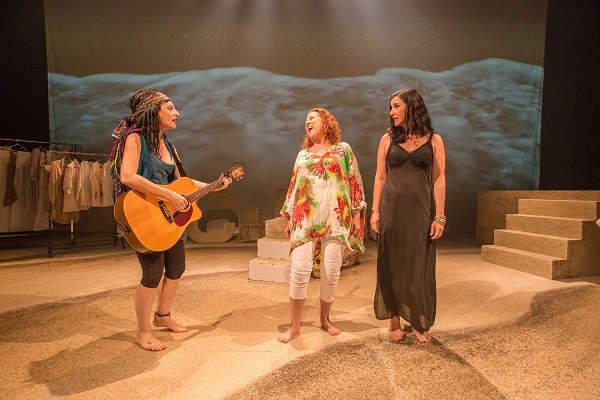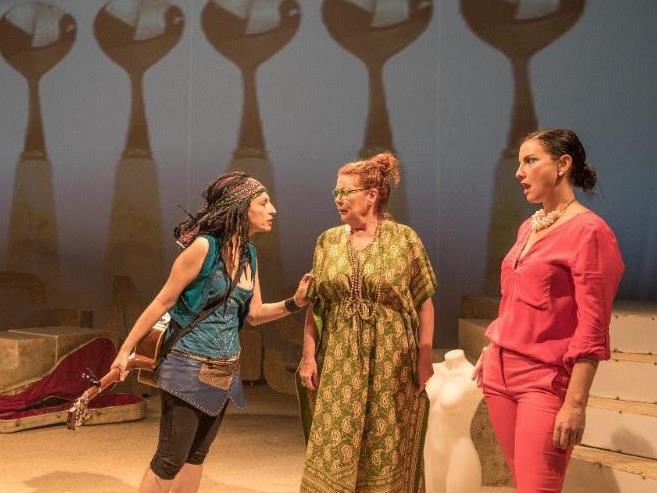Paradise is Singing, image via Jute Theatre Company.
This production is all about a sense of place – not the physical makeup, so much as the particular feeling that a place evokes in the observer. What is it that makes a place ‘special’? In Sydney, is it the Opera House or, in Paris, the Eiffel Tower? Not really. There’s more to it than that.
These three plays together demonstrate what makes Cairns so different. Its Esplanade, perhaps. Yes, but … again there’s more to it. Fifty years ago, Cairns had a lot of uniqueness – a steamy wet season, a heavy smell of bagasse in the air, clouds hanging low over its green mountain backdrop – and, yes, a mangrove-lined Esplanade where huge fig trees provided shade by day, and cover for drunks by night. It was exotic. It was the end of the line. People came and never went home. Now, while globalisation threatens to turn the city into just another tourist Mecca, this production sets out to dispel the idea that its phenomenal growth has robbed the city of its uniqueness. Each of its three interconnected stories is an exploration of that uniqueness that still persists.

Paradise is Singing, image via Jute Theatre Company.
The first, set on the ‘Nard – or the Esplanade, in official parlance – features the passing parade of locals, backpackers and middle-aged Melbournians seeking solace and sunshine. The home of permanent ‘derro’ fixtures like Wazza, and Gio, this backpacker strip is seen through the eyes and the songs of busker, Sue (Roz Pappalardo), whose marathon performance is spiced with a vibrant sarcasm. There is plenty of opportunity for her to exercise her vocal chords, as she sings of the tourists, locals and backpackers mixing it in the bars and dance clubs, getting drunk and ending up in fights on the ‘Nard at three in the morning. Cairns always was a bit rough if you knew when and where to look. It still is. Only the locale has changed.
In the second story, Rita (Rachel Terry), a former Cairnsite comes storming into the recently refurbished airport in a shocking pink pants suit and high heels. She is back from the ‘big smoke’ where she had gone to make her fortune as an ‘entrepreneuse’ (I just love that word, rhyming as it does with ‘purrs ‘and ‘errs’: it describes perfectly the kind of sleazy self-made prig that she has become). On arrival, she declares to her two sisters with every word, gesture and nuanced facial expression how sophisticated and superior her Sydney ventures have made her, and how much wealth her chain of ‘Aussie tourist trap’ shops will bring her when she sells out to wealthy Chinese interests. Her sisters, on the other hand, have remained ‘at home’ to care for their ailing mother in her dying days. She, of course, did not even bother to attend the funeral. Yes, this is a town mouse – country mouse story, with the inevitable ending. Rachel Terry in the lead role is absolutely stunning. From the moment she bursts on to the stage till the end when she is reduced to tears of remorse, she commands attention like an H-bomb on the horizon.
The third story brings forth a diffident, Melbourne resident, Moira (Susan Prince), who is holding a slide night for her fellow passengers just back from a coach tour (‘four days, five nights’) of the Far North. Armed with her trusty 60s model Zenit camera, she has taken snaps voraciously, as you do, and her commentary on these little gems of tourist behaviour is both naive and revelatory at one and the same time. Susan Prince delights in the opportunity to lampoon the temporary coach-tour bonhomie and the stock-standard Cairns itinerary – Green Island, the Tableland, Port Douglas, and especially the Reef Casino! With a wink and a nod, she delivers comic appraisals of her fellow passengers, whilst herself appearing to accept the fallacy that the coach tour is the ultimate Cairns experience. Susan Prince delivers another great solo performance in this piece, rounding off the three stories that depict the modern tropical Paradise,
The visual backdrops, projected on to the back of the set have been assembled by the set designers, Simone Tesorieri and Simona Cosentini. Along with the original and intriguing musical and sound-scapes by Quincy Grant, they constitute an essential (and delightful) feature of this production. Synchronised with the dialogue, the backdrops range from abstract images to lush tropical forests, and deserted beaches. Alongside the set and the action, they conjure up the precise feeling that explains what it is that makes the city unique. Tesorieri and Cosentini with their astute (often minimalist) designs are practically fixtures in JUTE productions, as is Jason Glenwright, the lighting designer, who can be relied upon to find the exact illumination to fit the changing moods of the plays he lights. All four have excelled themselves in this show.
To bring all of the disparate, but related, elements of this production together must have been no easy task. It is to the great credit of director, David Fenton, that he has been able to juggle everything from cast and crew to the demands of three different playwrights to create not just a trio of comedies (if indeed the play by Mark Gaal can be thus described, though I would argue it can), but also a crisp statement of the way it feels to live in Cairns in the early twenty-first century. If the theatre exists, as Hamlet says, “to hold, as ’twere, the mirror up to nature, to show virtue her own feature, scorn her own image, and the very age and body of the time”, then this indeed is the theatre we deserve, and are lucky to get. Once again, JUTE has lived up to its reputation of telling our own stories – and this time, a set of stories from right here in its own backyard. Don’t miss this wonderful opportunity to look into the mirror and laugh till you cry.
Rating: 4 1/2 stars out of 5
Paradise is Singing: Three Interlaced One-Act Plays
by Michael Gow, Mark Gaal and Kathryn Ash
Cast & Crew
Director: David Fenton
Playwright: Michael Gow, Mark Gaal and Kathryn Ash
Set Designer: Simone Tesorieri
Costume Designer: Simona Cosentini
Lighting Designer: Jason Glenwright
Sound Designer: Quincy Grant
AV Designer: Dave Masters
Technical Consultant: Sam Gibb
Featuring:
Roz Pappalardo
Rachel Terry
Susan Prince
Dates & Venues
7–22 October: JUTE Theatre, Centre of Contemporary Arts Cairns





